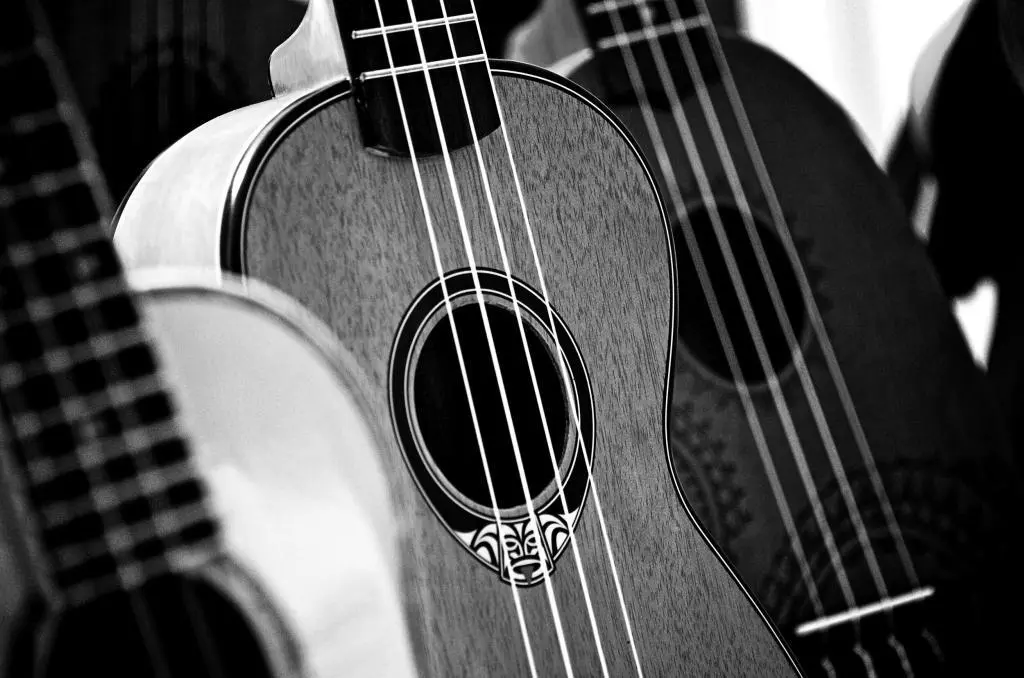Overtones are secondary frequencies that resonate every time a sound is produced, accompanying the primary or fundamental frequency. They add depth, richness, and character to the primary sound, making each musical note or sound unique in its timbre. While the fundamental frequency determines the pitch of a sound, the overtones shape its character and timbre. It’s the interplay between the two that gives each sound its unique identity.

What are Overtones: Table of Contents
Venture into the intricate realm of acoustics, and you’ll discover that sound is a multifaceted phenomenon. When an instrument is played or a voice sings, it’s not just a singular tone reaching our ears. Instead, it’s a harmonious blend of the main sound and its accompanying overtones.
Vibrations and Sound Waves: The Birth of Overtones
Picture a serene lake disturbed by a single pebble. The initial splash is soon followed by concentric ripples spreading outward. In a similar vein, when an instrument or voice produces a sound, it sets off vibrations. These vibrations, or sound waves, traverse the air, eventually gracing our ears and allowing us to discern sound. The most pronounced sound, the one we primarily perceive, is the fundamental frequency. Yet, lurking behind this dominant sound are subtler, quieter tones. These are our overtones, emerging from the intricate dance and interplay of sound waves. They infuse depth and nuance into the primary sound, crafting the distinct auditory signature of each instrument or voice.
Fundamental Frequency vs. Overtones: What’s the Difference?
At the core of any sound lies its fundamental frequency. This is the chief pitch we discern, the most potent vibration. If we were to liken sound to a canvas, the fundamental frequency would be the primary hue. Yet, a masterpiece isn’t crafted with a singular shade. It boasts a spectrum of colors, each adding dimension and detail. In our auditory world, these additional shades are the overtones. They layer atop the fundamental, enriching and diversifying the sound. The fundamental frequency sets the pitch, but the overtones? They breathe life and character into it.
In the grand symphony of sound, overtones are the subtle undertones, the nuanced harmonies that enrich every note. They’re the essence behind the diverse tapestry of music, and grasping their nature is pivotal for anyone keen on delving deep into sound and music production.
The Overtone Series: A Deep Dive
In the vast ocean of sound, overtones stand as the waves that shape the shores of music. They’re the silent architects behind the unique timbre of every instrument and voice. But to truly appreciate their role, one must dive deep into the overtone series and explore its intricate layers.
Harmonics and Overtones: Are They the Same?
The world of acoustics is filled with terms that often seem interchangeable. Two such terms that often create confusion are harmonics and overtones. While they are closely related, they are not quite identical twins in the sound family.
Dissecting the Harmonic Series
The harmonic series is a sequence of frequencies where each frequency is an integer multiple of a fundamental frequency. Imagine striking a note on a piano; the sound produced isn’t just that single note. Instead, it’s accompanied by a series of higher pitches, each fainter than the last. These are the harmonics. The first harmonic is the fundamental frequency itself, the second harmonic is twice the fundamental, the third is three times, and so on. This predictable pattern forms the backbone of the harmonic series.
Overtones: More than Just Harmonics?
While every harmonic (except the fundamental) is an overtone, not every overtone is a harmonic. Confused? Let’s simplify. Overtones are all the frequencies that resonate alongside the fundamental frequency. The first overtone is the second harmonic, the second overtone is the third harmonic, and so forth. However, in some cases, especially in non-linear systems or with certain instruments, overtones might not align perfectly with the integer multiples of the fundamental. These are called inharmonic overtones. So, while all harmonics are overtones, the reverse isn’t always true.
Instruments and Their Unique Overtones
Every instrument is a universe of sound, with its own set of overtones that give it a unique voice. From the deep resonance of a cello to the sharp trill of a piccolo, overtones are the secret ingredients in the recipe of an instrument’s timbre.
Strings, Winds, and Percussions: A Symphony of Overtones
Each family of instruments has its overtone signature. String instruments like violins and guitars produce overtones through the vibrations of their strings. The length, tension, and thickness of the string influence which overtones are more pronounced. Wind instruments, on the other hand, generate overtones through the vibrations of air columns. The shape and material of the instrument, as well as the technique of the player, can emphasize different overtones. Percussion instruments, especially those with a definite pitch like timpani, have a more complex overtone structure, influenced by the material, shape, and method of striking.
Why Does a Guitar Sound Different from a Flute?
At the heart of this difference lie overtones. A guitar, being a string instrument, has a rich set of overtones produced by the vibrations of its strings. These overtones blend with the fundamental frequency, creating the warm and resonant sound characteristic of guitars. A flute, however, relies on the vibrations of an air column. Its overtones are influenced by the instrument’s length, the placement of holes, and the player’s technique. This results in a purer, more ethereal sound. While both instruments might play the same note, their unique sets of overtones craft distinct auditory experiences.

The Color of Sound: How Overtones Shape Timbre
In the vibrant palette of sound, overtones are the hues that paint each note with its distinct character. Just as a painter uses different colors to bring a canvas to life, overtones color every sound, giving it depth, texture, and personality. This unique blend of overtones is what we refer to as ‘timbre’, and it’s the reason why the same musical note can evoke different emotions depending on the instrument playing it.
Listening to Timbre: Why Every Instrument Sounds Unique
Have you ever wondered why a C note played on a piano sounds so different from the same note played on a violin? The answer lies not in the fundamental frequency, which remains the same, but in the timbre of the sound. Timbre, often described as the ‘color’ or ‘tone quality’ of a sound, is what makes each musical voice unique.
The Role of Overtones in Defining Sound Quality
At the heart of timbre lies the intricate dance of overtones. While the fundamental frequency determines the pitch we hear, it’s the overtones that layer atop it, adding richness, warmth, brightness, or darkness to the sound. Think of it as sunlight filtering through a stained glass window. The fundamental frequency is the light, and the overtones are the colors of the glass, each adding its shade to the final spectrum. The specific combination and intensity of these overtones define the sound quality of an instrument or voice. It’s why a trumpet sounds brassy while a flute sounds airy, even if they play the same note.
From Bright to Mellow: How Overtones Influence Sound Color
Different instruments emphasize different overtones, leading to a wide spectrum of sound colors. An instrument that produces stronger higher overtones will have a brighter, sharper sound. Think of the crisp resonance of a xylophone or the piercing clarity of a piccolo. On the other hand, instruments that emphasize lower overtones produce a warmer, mellower sound, like the deep hum of a cello or the soft whisper of a bassoon. The artistry of a musician also plays a role. By manipulating how they play, musicians can emphasize or suppress certain overtones, further shaping the color of the sound.

Practical Magic: Overtones in Music Production
In the realm of music production, overtones are more than just theoretical concepts; they’re the tools that shape the very essence of sound. Whether you’re a seasoned producer or a budding audio engineer, understanding and harnessing the power of overtones can elevate your soundscapes to new heights. Let’s delve into the practical magic of overtones and discover how they’re used to craft sonic masterpieces.
Crafting the Perfect Sound: Overtones in the Studio
The studio is a playground for sound, and overtones are some of the most versatile toys in the sandbox. By manipulating overtones, producers can transform a simple sound into a symphonic experience.
Mixing, Editing, and the Overtone Series
Every sound in a mix carries its own set of overtones. When mixing, it’s crucial to understand how these overtones interact. Layering sounds with clashing overtones can muddy a mix, while complementary overtones can enhance clarity and depth. Editing tools like equalizers and filters can be used to boost or cut specific overtones, allowing producers to shape the timbre of individual tracks. By understanding the overtone series, producers can make informed decisions, ensuring that each element in a mix shines without overshadowing others.
Enhancing Audible Overtones for a Richer Sound
Sometimes, a track needs that extra sparkle, a richness that makes it stand out. This is where overtone enhancement comes into play. Techniques like harmonic excitation can introduce or amplify specific overtones, adding warmth to bass frequencies or brilliance to higher registers. By selectively enhancing overtones, producers can breathe life into a flat sound, making it resonate more deeply with listeners.
Real-world Overtone Wonders
Beyond the studio, overtones create auditory wonders that have captivated listeners for generations. These natural phenomena showcase the incredible power and beauty of overtones in action.
The Barbershop Quartet’s “Phantom” Pitches
One of the most enchanting examples of overtone magic is the “phantom” or “fifth voice” often heard in barbershop quartets. When the quartet’s four voices harmonize perfectly, the overtones from each voice combine to produce a pitch that isn’t being sung by any member. This “phantom” pitch is a testament to the power of overtones and their ability to create rich, multi-layered harmonies.
How Well-Tuned Instruments Elevate Overtones
A well-tuned instrument doesn’t just play the right notes; it produces a cascade of harmonious overtones. Whether it’s the resonant chime of a perfectly tuned piano or the rich harmonies of a finely-tuned violin, the clarity and depth of the sound are amplified by the instrument’s overtones. Musicians often speak of the “sweet spot” when tuning, a point where the fundamental and its overtones resonate in perfect harmony, creating a sound that’s pure and full of depth.
The Science Behind Overtones: A Closer Look
The world of overtones is not just an artistic realm; it’s deeply rooted in science. By understanding the physics and mathematics behind overtones, we can gain a clearer insight into why they play such a pivotal role in shaping the sounds around us. Let’s embark on a journey through the scientific landscape of overtones.
Waveforms and Their Overtone Secrets
At the heart of every sound lies a waveform, a visual representation of the sound’s pressure changes over time. These waveforms are not just arbitrary shapes; they carry the secrets of a sound’s overtone structure.
Sine Waves, Saw Waves, Square Waves: How They Shape Overtones
- Sine Waves: The purest of all waveforms, a sine wave represents a single frequency with no overtones. It’s the foundational building block of all other sounds. When you hear a sine wave, you’re hearing a sound devoid of any additional color or texture.
- Saw Waves: Rich in harmonics, the saw wave is like the bustling city to the sine wave’s quiet countryside. It contains both even and odd harmonics, making it rich and buzzy. Its overtone structure is what gives synthesizers and certain string instruments their characteristic bright and edgy sound.
- Square Waves: With a timbre that’s both hollow and woody, square waves only contain odd harmonics. This gives them a sound that’s distinct from both sine and saw waves. They’re often associated with certain woodwind instruments and vintage synthesizers.
Each waveform has its unique overtone signature, and by combining and manipulating these waveforms, sound designers and musicians can craft a vast array of sonic textures.
The Relationship Between Wavelength, Frequency, and Overtones
Sound travels in waves, and these waves have specific properties that determine how we perceive them. Among these properties are wavelength and frequency, two concepts intrinsically linked to the world of overtones.
Basic Wave Principles and Their Overtone Impacts
- Wavelength: This is the distance between two consecutive peaks (or troughs) of a wave. In terms of overtones, shorter wavelengths correspond to higher frequencies and thus higher overtones.
- Frequency: It’s the rate at which a wave oscillates in one second. Higher frequencies produce higher-pitched sounds. The fundamental frequency of a sound is its most dominant frequency, but overtones are the additional frequencies that resonate alongside it. As we move up the overtone series, the frequency increases, and so does the pitch.
Understanding the relationship between wavelength, frequency, and overtones is crucial for anyone delving into the science of sound. It’s the bridge that connects the abstract world of music theory with the tangible realm of physics.
The science of overtones is a fascinating blend of physics, mathematics, and art. By understanding the principles that govern overtones, we can better appreciate the rich tapestry of sounds that fill our world. Whether you’re a musician, a sound engineer, or just someone curious about the world of sound, the science behind overtones offers a treasure trove of insights waiting to be discovered.
Overtones to Embrace and Avoid in Music Production
In the intricate dance of music production, overtones play a dual role. They can be the secret ingredient that adds depth and richness to a track, or the unwanted noise that muddies the mix. Knowing which overtones to embrace and which to avoid is crucial for any producer aiming to craft a sonic masterpiece.
The Good, the Bad, and the Ugly of Overtones
Like characters in a story, overtones come with their own personalities. Some add harmony and depth, while others introduce discord and chaos. Recognizing the heroes from the villains in the overtone world can make all the difference in the final mix.
Crafting Harmonious Sounds: Overtones to Seek
When aiming for a rich and full sound, certain overtones are your best allies:
- Harmonic Overtones: These are integer multiples of the fundamental frequency and tend to blend seamlessly with the main sound, adding layers of depth. They’re the backbone of harmonious sounds in most musical genres.
- Resonant Overtones: Found in instruments like guitars and violins, these overtones enhance the instrument’s natural resonance, giving it a warm and vibrant tone.
- Subtle High-Frequency Overtones: These can add a touch of brightness or “air” to vocals or instruments, making them stand out in a mix without being overpowering.
Steering Clear of Unpleasant Overtones
While many overtones enhance sound, some can be disruptive:
- Inharmonic Overtones: These don’t align with the natural harmonic series and can introduce a sense of dissonance or “off-ness” to a sound. They’re often the culprits behind sounds that feel out of place or jarring in a mix.
- Overpowering Low-Frequency Overtones: While bass can add warmth, too much of it can muddy a mix, making it sound boomy or undefined.
- Clashing Overtones: When layering sounds, it’s crucial to ensure that the overtones of one don’t clash with another. This can create a cacophony, where the mix feels crowded and chaotic.
FAQs: Unraveling the Mysteries of Overtones
The world of overtones is both fascinating and intricate, playing a pivotal role in shaping the sounds we hear in music. Whether you’re a budding musician, an aspiring sound engineer, or simply curious about the science of sound, understanding overtones can provide valuable insights. In this FAQ section, we delve deep into the most frequently asked questions about overtones, offering clear and concise answers to quench your sonic curiosity.
Are overtones and harmonics the same thing?
Not exactly. While all harmonics (except the fundamental) are overtones, not all overtones are harmonics. Harmonics are integer multiples of the fundamental frequency. Overtones include all frequencies that resonate alongside the fundamental, including those that aren’t perfect integer multiples.
Are overtones good for sound quality?
Yes, overtones play a crucial role in determining the timbre or color of a sound. They add depth, richness, and character to the primary sound, making each musical note or instrument unique in its resonance.
How can one produce overtones?
Overtones are naturally produced when an object, like a musical instrument or vocal cords, vibrates. The primary vibration produces the fundamental frequency, while additional, more rapid vibrations produce the overtones.
What techniques are used to produce overtones on an alto sax?
On an alto sax, overtones are produced by using specific fingering techniques combined with controlled embouchure and airflow. Practicing overtone exercises helps in achieving a richer sound and better pitch control.
How are overtones generated on a violin?
On a violin, overtones are generated when the bow interacts with the strings. The primary vibration of the string produces the fundamental frequency, while the string’s segmented vibrations produce the overtones.
Can vocal cords produce overtones?
Absolutely! Vocal cords naturally produce overtones when they vibrate. The richness and uniqueness of each person’s voice come from the specific overtone series they produce.
How do overtones influence the overall sound quality of an instrument or voice?
Overtones determine the timbre or color of a sound. The specific combination and intensity of overtones in a sound make it bright, warm, sharp, mellow, or any other tonal quality. It’s the overtones that make a piano sound different from a flute, even when playing the same note.
How do different musical instruments produce their unique overtone series?
Each instrument has its own method of producing sound, whether through vibrating strings, air columns, or membranes. The material, design, and method of sound production of the instrument determine its unique overtone series.
How do waveforms influence the production of overtones?
Waveforms represent the shape and form of sound waves. Different waveforms, like sine, saw, and square waves, have distinct overtone structures. By manipulating these waveforms, sound designers can craft various sonic textures.
Are there specific overtones that can disrupt sound quality in music production?
Yes, inharmonic overtones or those that clash with other elements in a mix can introduce dissonance and disrupt sound quality. Identifying and reducing or eliminating these overtones can lead to a clearer and more harmonious final product.
What is the difference between the fundamental frequency and overtones?
The fundamental frequency is the primary and most dominant frequency of a sound. Overtones are the additional, higher-pitched frequencies that resonate alongside the fundamental, adding depth and richness to the sound.
Why do some overtones sound harmonious while others sound discordant?
Overtones that align with the natural harmonic series tend to sound harmonious as they blend seamlessly with the fundamental frequency. In contrast, inharmonic overtones, which don’t align perfectly with the harmonic series, can introduce a sense of dissonance.

